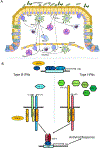Type III IFNs: Beyond antiviral protection
- PMID: 31771761
- PMCID: PMC7141597
- DOI: 10.1016/j.smim.2019.101303
Type III IFNs: Beyond antiviral protection
Abstract
The unexpected discovery of a novel family of antiviral mediators, type III IFNs or IFN-λs, challenged the widely accepted primacy of type I IFNs in antiviral immunity, and it is now well recognized that the IFN-λ-based antiviral system plays a major role in antiviral protection of epithelial barriers. The recent characterization of previously unknown IFN-λ-mediated activities has prompted further reassessment of the role of type I IFNs in innate and adaptive immune and inflammatory responses. Since type I and type III IFNs are co-produced in response to a variety of stimuli, it is likely that many physiological processes are simultaneously and coordinately regulated by these cytokines in pathological conditions, and likely at steady state, as baseline expression of both IFN types is maintained by microbiota. In this review, we discuss emerging differences in the production and signaling of type I and type III IFNs, and summarize results of recent studies describing the involvement of type III IFNs in anti-bacterial and anti-fungal, as well as antiviral, defenses.
Keywords: Antiviral protection; Epithelial barrier; Immune response; Interferon; Microbial infection; Neutrophils.
Copyright © 2019 Elsevier Ltd. All rights reserved.
Conflict of interest statement
Competing interests: S.V.K. is an inventor on patents and patent applications related to IFN-λs, which have been licensed for commercial development. All other authors declare they have no competing interests.
Figures

References
-
- Isaacs A, Lindenmann J, Virus Interference: 1. The interferon., Proc R Sod Lond B, 1957, pp. 258–267. - PubMed
-
- Kotenko SV, Gallagher G, Baurin VV, Lewis-Antes A, Shen M, Shah NK, Langer JA, Sheikh F, Dickensheets H, Donnelly RP, IFN-lambdas mediate antiviral protection through a distinct class II cytokine receptor complex, Nat. Immunol, 4 (2003) 69–77. - PubMed
-
- Sheppard P, Kindsvogel W, Xu W, Henderson K, Schlutsmeyer S, Whitmore TE, Kuestner R, Garrigues U, Birks C, Roraback J, Ostrander C, Dong D, Shin J, Presnell S, Fox B, Haldeman B, Cooper E, Taft D, Gilbert T, Grant FJ, Tackett M, Krivan W, McKnight G, Clegg C, Foster D, Klucher KM, IL-28, IL-29 and their class II cytokine receptor IL-28R, Nat. Immunol, 4 (2003) 63–68. - PubMed
Publication types
MeSH terms
Substances
Grants and funding
LinkOut - more resources
Full Text Sources
Medical

